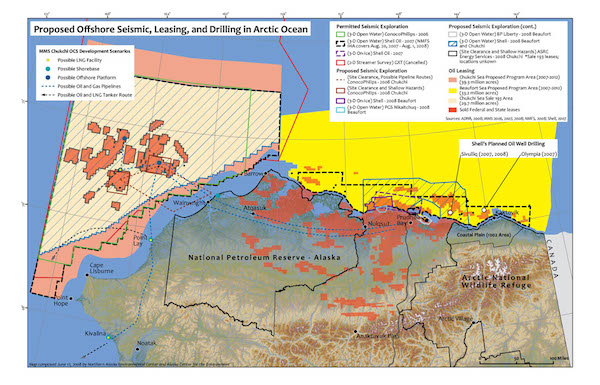Jul 14 2015
Shell Oil is gearing up to do the first new exploratory drilling in the Chukchi Sea off northwestern Alaska. The project has been in the pipeline for years, and has faced numerous legal challenges (mostly regarding the danger of a spill and climate imperatives) and logistical snafus (the most extreme being a drill ship that ran aground). Just last month, a consortium of environmental groups filed a suit challenging the most recent permits; there has yet to be a ruling. The expansion of oil and gas development from Alaska’s north slope to offshore waters will create a marked increase in human noise in an ocean region that is currently relatively free of our intrusions. Exploration leases have been sold in both the Chukchi Sea (left below) and Beaufort Sea (right below).

Earlier this year, the Obama administration officially put some areas in these waters off limits, but a close inspection of the maps presented then reveal that virtually none of these areas were planned for development when the above map was created in 2008; the exclusion zones appear to match the near-shore areas excluded above (one exception: a small portion of the Chukchi zone is now off-limits).
Noise concerns extend far beyond the drilling itself, or even the seismic surveys that take place prior to drilling and during the life of the project. The drill rigs come along with a support fleet of 30 other boats and several aircraft, promising a steady din in the area. “In the Arctic, I can’t emphasize how novel an activity this is,” says NRDC attorney Giulia Good Stefani. “It really is a whole new level of disturbance for an area already experiencing rapid change and stress.” Concerns extend from whales to walruses, seals, and polar bears.
A wide array of ongoing research is underway, aiming to characterize the current soundscape in arctic waters. Read the rest of this entry »
Apr 07 2011
Two new studies on seismic survey impacts have been released by the Joint Industry Program (JIP) Sound and Marine Life research program, funded by oil and gas companies.
The first looked at the effectiveness of “soft start” ramp up of seismic survey airguns at night and at times of poor visibility. This has become standard procedure, but there have been some concerns that if marine mammals were very close to the ship, even the low sound levels at the start of the ramp up could be loud enough to cause hearing damage. Based on two different modeling approaches, the study found “no instances…in which the threshold levels for hearing injury for cetaceans were reached during the initial stages of the soft-start sequence. This suggests that the animals are not at significantly greater risk of harm when a soft start is initiated in low visibility conditions.” Link to pdf of report at the website of the International Association of OIl and Gas Producers.
The second study aimed to address “the rarely-charted relationship between oil Exploration and Production (E&P) activities and trends in cetacean stocks.” The study cites case studies involving populations of sperm whales in the Gulf of Mexico, humpback whales, blue whales and fin whales off the coast of California, northern bottlenose whales off Nova Scotia and harbour porpoises and minke whales off the east coast of the UK. The study, published in Aquatic Mammals, provided new insights into the worldwide distribution of E&P activity in relation to marine mammal populations and has also revealed striking data gaps in our understanding of cetacean population numbers and trends. While the report’s review of seven stocks “found signs of an increase in numbers in one population (Californian humpback whales),” for the remaining six, “population trends could not be assessed due to the high variability in the abundance estimates.” Link to pdf of this report.
In essence, there is not enough data to really tell us whether ongoing oil and gas activity has reduced stocks over the long term. As usual in the many cases where ocean noise and population studies come up against this paucity of solid data, the researchers recommend that someone should fund of future studies ‘that provide more comprehensive data on cetacean stocks.”
JIP research page
Main JIP website
OGP publications page
OGP main page
May 08 2008
A surge in lease sales along Alaska’s west and north coasts has spurred predictable resistance from locals and environmental groups. While the effect of any possible oil spills in harsh waters is certainly a major focus of concerns being voiced, the impacts of the first phase of oil and gas exploration have moved to the forefront of discussions. The oil industry is gearing up to explore a record number of offshore lease areas in the next few years, and this summer, up to five seismic survey vessels are scheduled to be off the Alaskan coast, firing airguns 2-4 times per minute and listening for the echoes Read the rest of this entry »

